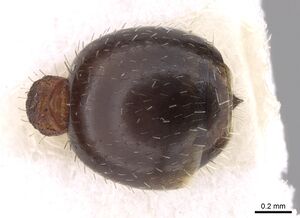Temnothorax inermis
| Temnothorax inermis | |
|---|---|

| |
| Scientific classification | |
| Kingdom: | Animalia |
| Phylum: | Arthropoda |
| Class: | Insecta |
| Order: | Hymenoptera |
| Family: | Formicidae |
| Subfamily: | Myrmicinae |
| Tribe: | Crematogastrini |
| Genus: | Temnothorax |
| Species: | T. inermis |
| Binomial name | |
| Temnothorax inermis (Forel, 1902) | |
Identification
Keys including this Species
Distribution
Distribution based on Regional Taxon Lists
Oriental Region: India (type locality).
Distribution based on AntMaps
Distribution based on AntWeb specimens
Check data from AntWeb
Countries Occupied
| Number of countries occupied by this species based on AntWiki Regional Taxon Lists. In general, fewer countries occupied indicates a narrower range, while more countries indicates a more widespread species. |

|
Estimated Abundance
| Relative abundance based on number of AntMaps records per species (this species within the purple bar). Fewer records (to the left) indicates a less abundant/encountered species while more records (to the right) indicates more abundant/encountered species. |

|
Biology
Castes
Images from AntWeb

| |
| Worker. Specimen code casent0906162. Photographer Cerise Chen, uploaded by California Academy of Sciences. | Owned by NHMUK, London, UK. |
Nomenclature
The following information is derived from Barry Bolton's Online Catalogue of the Ants of the World.
- inermis. Leptothorax inermis Forel, 1902c: 229 (w.) INDIA. Combination in Temnothorax: Bolton, 2003: 271. See also: Bingham, 1903: 215.
Description
Unless otherwise noted the text for the remainder of this section is reported from (Bingham 1903)
Worker
Head and thorax dark brown, almost black; mandibles, antennae, legs and pedicel chestnut-brown, abdomen dark chestnut-brown; head and thorax shining, very slightly longitudinally rugose, taking in certain lights the appearance of being widely striate ; the legs, pedicel and abdomen smooth, highly polished and shining ; pilosity almost entirely wanting, reduced to a few very scattered hairs; pubescence on the scape of the antennae and the tibiae recumbent. Head a little longer than broad and as broad in front as posteriorly, the sides of the head somewhat convex; mandibles subtriangular, the masticatory margin armed with 5 small teeth; clypeus with the medial portion slightly convex, rounded posteriorly, anterior margin transverse; antennae rather short, the scape curved near the base, not reaching the top of the head; eyes lateral, situated about the middle of the head. Thorax anteriorly rounded and convex, the basal portion of the metanotum rectangular, rounded above, truncate posteriorly, unarmed, but with half-obsolete lateral tubercles. Pedicel: the 1st node cuneiform, petiolate anteriorly, obtuse, rather transverse above; '2nd node convex above, about as broad as long; abdomen oval, slightly transverse anteriorly.
Length: 4 mm.
Habitat: Recorded from Dharmsala (Sage).
References
- Bingham, C. T. 1903. The fauna of British India, including Ceylon and Burma. Hymenoptera, Vol. II. Ants and Cuckoo-wasps. London: Taylor and Francis, 506 pp. (page 215, see also)
- Bolton, B. 2003. Synopsis and Classification of Formicidae. Mem. Am. Entomol. Inst. 71: 370pp (page 271, Combination in Temnothorax)
- Forel, A. 1902c. Myrmicinae nouveaux de l'Inde et de Ceylan. Rev. Suisse Zool. 10: 165-249 (page 229, worker described)
- Santschi, F. 1909c. Leptothorax rottenbergi et espèces voisines. Rev. Suisse Zool. 17: 459-482 (page 468, fig. 2 worker, queen described)
- Santschi, F. 1912c. Quelques nouvelles variétés de fourmis africaines. Bull. Soc. Hist. Nat. Afr. Nord 3: 147-149 (page 149, Replacement name: anacanthus)
- Yusupov, Z.M., Dubovikoff, D.A., Lopatina, E.B. 2020. Temnothorax kipyatkovi sp. n. – a new species of ants (Hymenoptera: Formicidae) from India. Caucasian Entomological Bulletin 16, 353–357 (doi:10.23885/181433262020162-353357).
References based on Global Ant Biodiversity Informatics
- Forel A. 1902. Myrmicinae nouveaux de l'Inde et de Ceylan. Rev. Suisse Zool. 10: 165-249.
- Forel A. 1903. Les Formicides de l'Empire des Indes et de Ceylan. Part X. J. Bombay Nat. Hist. Soc. 14: 679-715.
- Forel A. 1906. Les fourmis de l'Himalaya. Bulletin de la Société Vaudoise des Sciences Naturelles 42: 79-94.

